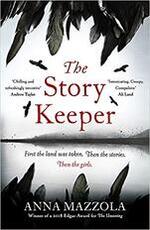
TITLE: The Story Keeper
AUTHOR: Anna Mazzola
PUBLISHER: Tinder Press, 2018
ISBN: 1472234782
PODCAST EPISODE: Episode 70
REVIEWER: Mark Norman
“First the land was taken. Then the stories. Then the girls”
Anna Mazzola’s first book, The Unseeing was a dark Victorian crime novel based on the actual murder of Hannah Brown in poverty-striken London. For her second novel, Anna again uses an actual mystery for the basis of her plot. In this case, she draws on the West Ham vanishings - a spate of disappearances of children from the East End of London in the 1880s.
This time, Anna chooses to relocate the story from London to the Isle of Skye. The reason for this is to allow the characters to be embedded in a landscape rich in folklore and storytelling; to centre the tale unusually around a female folklore collector (reminiscent of Katharine Briggs perhaps, but based on a couple of actual collectors) and her young protege.
The landscape of the Isle of Skye is equally as turbulent as the Victorian East End, but for other reasons. The ‘land’ in the book’s tag-line refers to the Highland Clearances. The ‘stories’ relate to the dark fairy folklore which Anna draws on from the more superstitious times that the book is set. The ‘girls’ are the young children who are disappearing once again. But at whose hand? Is it the fairies or some other spirit that are truly taking them as many of the villagers believe? Or is there another agency at work?
Were this just a crime novel set in another place or time, the story would be engaging enough. But for its interplay with folklore, superstition and some very difficult periods of our social history, the story will draw in and hold fast anyone with an interest in tradition and belief, or story-telling in a community for example.
What this book also does is demonstrate the sheer skill that Anna has as an historical researcher. Her use of the source material is in-depth, relevant and respectful and the book does as much to educate as it does to entertain. It’s a story that will stand more than one read and should find a welcome home on any folklorist’s fiction shelf. Highly recommended.
AUTHOR: Anna Mazzola
PUBLISHER: Tinder Press, 2018
ISBN: 1472234782
PODCAST EPISODE: Episode 70
REVIEWER: Mark Norman
“First the land was taken. Then the stories. Then the girls”
Anna Mazzola’s first book, The Unseeing was a dark Victorian crime novel based on the actual murder of Hannah Brown in poverty-striken London. For her second novel, Anna again uses an actual mystery for the basis of her plot. In this case, she draws on the West Ham vanishings - a spate of disappearances of children from the East End of London in the 1880s.
This time, Anna chooses to relocate the story from London to the Isle of Skye. The reason for this is to allow the characters to be embedded in a landscape rich in folklore and storytelling; to centre the tale unusually around a female folklore collector (reminiscent of Katharine Briggs perhaps, but based on a couple of actual collectors) and her young protege.
The landscape of the Isle of Skye is equally as turbulent as the Victorian East End, but for other reasons. The ‘land’ in the book’s tag-line refers to the Highland Clearances. The ‘stories’ relate to the dark fairy folklore which Anna draws on from the more superstitious times that the book is set. The ‘girls’ are the young children who are disappearing once again. But at whose hand? Is it the fairies or some other spirit that are truly taking them as many of the villagers believe? Or is there another agency at work?
Were this just a crime novel set in another place or time, the story would be engaging enough. But for its interplay with folklore, superstition and some very difficult periods of our social history, the story will draw in and hold fast anyone with an interest in tradition and belief, or story-telling in a community for example.
What this book also does is demonstrate the sheer skill that Anna has as an historical researcher. Her use of the source material is in-depth, relevant and respectful and the book does as much to educate as it does to entertain. It’s a story that will stand more than one read and should find a welcome home on any folklorist’s fiction shelf. Highly recommended.